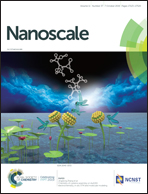Integration of multi-scale defects for optimizing thermoelectric properties of n-type Cu1−xCdxFeS2 (x = 0–0.1)†
Abstract
The performance of thermoelectric (TE) materials is strongly influenced by multi-scale defects. Some defects can improve the TE performance but some are unfavorable. Therefore, the multi-scale defects need to be integrated rationally to enhance the TE properties. Here, the defects including atomic-scale point defects, high-density grain boundaries and nano-precipitates were integrated into CuFeS2, an n-type and Earth-abundant TE material. Primitively, a Cd dopant with high scattering factor was introduced to form  point defects in Cu1−xCdxFeS2 (x = 0–0.1) according to the calculated scattering parameters. Furthermore, the processes of quenching, annealing, high-energy ball milling (QAH) and sintering were carried out to integrate the multi-scale defects into Cu1−xCdxFeS2. The results suggested that
point defects in Cu1−xCdxFeS2 (x = 0–0.1) according to the calculated scattering parameters. Furthermore, the processes of quenching, annealing, high-energy ball milling (QAH) and sintering were carried out to integrate the multi-scale defects into Cu1−xCdxFeS2. The results suggested that  point defects and
point defects and  antisite defects were achieved and the unfavorable Cd′Fe defects were suppressed effectively, leading to a higher electrical conductivity. Moreover, the CdS nano-precipitates played a vital role in carrier filtering to increase the Seebeck coefficient. Meanwhile, the high-density grain boundaries suppressed the lattice thermal conductivity. As a result, a peak ZT value of 0.39 at 723 K was obtained in Cu0.92Cd0.08FeS2, which is the highest value reported so far in the CuFeS2 family.
antisite defects were achieved and the unfavorable Cd′Fe defects were suppressed effectively, leading to a higher electrical conductivity. Moreover, the CdS nano-precipitates played a vital role in carrier filtering to increase the Seebeck coefficient. Meanwhile, the high-density grain boundaries suppressed the lattice thermal conductivity. As a result, a peak ZT value of 0.39 at 723 K was obtained in Cu0.92Cd0.08FeS2, which is the highest value reported so far in the CuFeS2 family.

- This article is part of the themed collection: Editor’s Choice: Thermoelectric nanostructures


 Please wait while we load your content...
Please wait while we load your content...